|
PACmeter - Popularity, Authority, Credibility Online: How To
Measure Them?
Popularity
The quality of being widely accepted, sought after or admired.
www.cogsci.princeton.edu/cgi-bin/webwn
Authority
Power of influence, either granted to or developed by individuals, that leads
to others doing what those individuals direct.
www.dhs.state.or.us/admin/ois/pmo/publications/pmo_glossary.html
A measure of how reliable a source of information is. Is the article wriitten
by a recognized expert in the field? Is it based on research?
www.mc.cc.md.us/library/libtp/glossary.htm
Credibility
The quality of being believable or trustworthy.
www.cogsci.princeton.edu/cgi-bin/webwn
The quality of being plausible, believable, dependable, or worthy of confidence.
Glossary Web Archive
If you use the Internet Explorer browser, both the
Google Toolbar and the
Alexa Toolbar have a feature which shows
the popularity of the Web site you are currently viewing. The Google PageRank is
used by many companies, agencies and consulting firms to easily assess the authority
and popularity of any Web site. In recent times even the advertising prices of a
site have been determined in relationship to the
Google PageRank.
Alexa's uses traffic popularity, which measures
how many users of the Alexa Toolbar visit a certain site. But given the rapid demise
of Internet Explorer and the fast growing interest of many Web publishers to increase
their credibility and authority online there is a renewed interest in research,
tools and services that can facilitate the task of measuring a Web site credibility,
authority and popularity on the Internet.
Though most Web site owners have direct access to detailed, precise and
easily manageable data coming form their own Web servers logs (these are files on
a Web server which are automatically created and which contain precise data about
each visitor origin, path through your site, time on each page and much more) very
few know how to access, manage and make sense of this information, let alone being
able to be able in some way to compare such stats with the ones of other comparable
or competing Web sites.
Log analysis tools and live tracking services offer very valuable means
to measure the traffic of a Web site, its demographics and technographics but offer
very little in the way of helping an independent Web publisher assess the credibility,
authority or popularity of Web sites that are not under her control.
This mini-guide brings together the best public resources available today
on the Web that facilitate the task of assessing the credibility, authority and
popularity of any Web site. When this is not directly feasible it offers resources
and guidelines on how to personally assess and evaluate such factors.
In general, it can be said that there is not one
unique, reliable indicator of credibility, authority and popularity for public Web
sites.Rather, there are a multiplicity of Web indicators that can be utilized
to gather valuable data about a web site depending on the specific needs and scope
of such research.
For ease of explanation I have grouped these Web credibility indicators
in five basic sets:
a) Public Link Popularity Indicators
b) Google PageRank
c) Site Stats - (from server logs, live tracker, ad impressions, etc.)
d) Advertising Performance Indicators
e) Other Popularity Indicators
Public Link Popularity Indicators
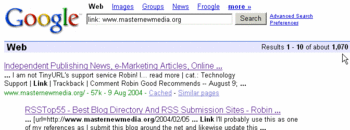
Link popularity is probably the most objective and publicly accessible credibility
and authority indicator for anyone Web site. The
link popularity of a site can be calculated through the ability of major search
engines to report on backward links to anyone site through a simple manual query
that anyone can carr out.
Unfortunately there are also a few drawbacks: the syntax to carry out
this type of search varies across search engines. Worse than this, not all pages
of every Web site are indexed and even Google is not able to provide a fully exhaustive
calculus of the absolute number of sites connecting to a domain. So, like in similar
situations, one can draw some valuable indications by looking at multiple results
from different sources.
Here are some things I have learned along the way:
1)
Finding
Inbound Links in Google
2) Finding Inbound Links in Yahoo Search
syntax: link:URL
(e.g.: link:http://www.masternewmedia.org/)
3) Finding
Inbound Links With Other Major Search Engines
4) Linking Popularity Check by
MarketLeap
This is an excellent, free, top quality service which allows you to effectively
measure the link popularity of any Web site. This service allows to compare a selected
site with up to three other sites, and also to a larger preselected sample of Web
sites from the same interest area.
Reviewed in "How
To Measure Link Popularity"
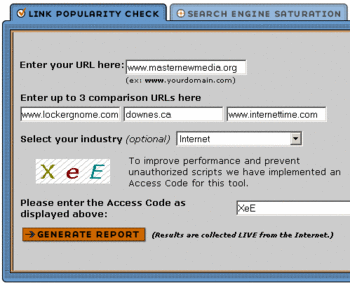
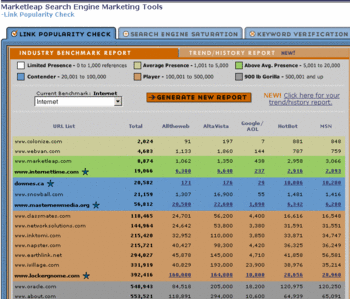
5) Link Popularity Check by MarketPosition
Online, Web-based service which measures the link popularity of any Web site against
three reference URLs.
6) Check Your Link Popularity
A very effective and simple to use Windows utility (freeware). It checks very rapidly
on Hobot/Google, AllTheWeb, AltaVista, Hotbot/Inktomi and MSN Search to see all
of the inblund links to all of the sites you specify. It then dinamically builds
a list of all the sites according to their link popularity overall score. Used with
relevant competitors and other sites in the same sector it offers a very valuable
and reliable indicator of a Web site authority in its field. It contains no adware
or spyware and it is a reliable, trusted tool. It is free because it is sponsored
by Axandra software.
Immediate free download
here.
7) LinkSurvey
Link Survey is a link popularity checking tool that is a must for any Webmaster.
Just enter in the Website(s) for which you want to check the link popularity, and
hit the start button. Immediately, Link Survey sends a query out to many popular
search engines and displays the results in a table format. From there, you can use
the built-in, multi-tabbed Web browser to check out the Web sites that have linked
to your pre-selected site. Link Survey also allws data export your to text, HTML,
Excel file formats.
8) LinkPopularity
Free and simple free online service that helps you generate link lists from three
major search engines. Results can also be emailed each month.
9) Compute Your
Own Web Traffic Rank
Jakob Nielsen own empirical approach to derive
site popularity relative to its largest competitor. Though the method is dated over
6 years, and it references Alexa's (dubious)
abilities, it nonetheless offers a complementary perspective on how to measure popularity
and it adds one extra measurement weapon to our ammunition set.
Google Page Rank

Google PageRank is one of the very classic credibility and authority indicators
on the Web and also one of the most trusted and reliable ones.
If you use the Internet Explorer browser,
the Google Toolbar shows the popularity
of any Web site you are currently viewing by way of a small green indicator called
PageRank�.
PageRank� is an exclusive technology of Google which evaluates the popularity
of your Website's pages with a ranking value ranging between 0 and 10. However,
in order to know this Rank, you have to download and to install the
Google Toolbar.
Check Google PageRank
Prog (formerly proogle)
Measures Google PageRank without needing to have the toolbar, plus it provides listing
of all of the inbound links with relative PageRank for each one.
Indicateur De Page Rank
Another Web-based solution to measure Google PageRank without needing to have the
toolbar. Minimalist approach, no distractions, fast response.
Check PageRank with Mozilla/Firefox.
View PageRank for multiple Web sites at once
without installing Google Toolbar.
Alternatively use:
http://www.top25web.com/pagerank.php
MyRank Online
http://my.rank.online.fr/
(not available anymore)
MyRankOnline was created to enable webmasters to easily publish the PageRank
of their site on their own Web pages without any Toolbar.
PageRank for Mac users
Guide to Understanding Google Page Rank
Google Pagerank Explained, Defined, Best Reference Resources
PageRank Explained Correctly
With Examples
Server Logs Statisitics - Web Traffic Data
Though I am aware of breaking out from the traditional approach to the
use of Web server statistics, but I would strongly suggest independent publishers,
reporters, bloggers and online journalists of all kinds, to make (a representative
sample) of their log server stats publicly available.
Log server statistics
are files that are automatically created on the Web server hosting your site and
documenting in a high level of technical detail each and every access to your site.
My recommendation is: Make it completely transparent for everyone to see how
well you are doing.
The more transparent you are, the more credible your information will be.
Some of you may correctly note that it would be quite easy for some unscrupolous
webmasters to easily fake some of their own traffic statistics. While this may be
certainly true, it also provides an interesting opportunity for vendors of log server
analysis and live tracking software to start providing a "certified" offerings to
their package, allowing publication of somewhat more trustworthy data under the
control/verification of a third-party entity.
So, while it may be hard to find public traffic statistics for a while still,
look for official (or unofficial) traffic data whenever you can. If it is not available
publicly, request access to the non-public data. If the data is locked behind a
secure account ask them to provide you with a signed screenshot set ("signed" meaning
that they will certify their screenshots not to have been tampered digitally). But
do look at server logs data if you want to have the real story on any site.
These are the important indicators, within Web site traffic statistics,
to look for:
Number of daily unique visitors.
This is a specific value that says a lot about any site popularity and traffic.
Don't be confused by the statistic called "hit". Consider "hits" useless. No value
whatsoever is assessing the credibility and authority of a Web site. If you see
a site bragging about the number of "hits" it has, you are looking at a non-credible
site. Period.
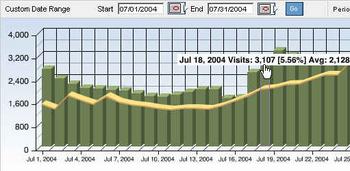
Page Views.
This critical indicator says how many page views your site has received. Since one
visitor can view multiple pages, it is important to understand whether the site
prompts the user for extra reading or not.
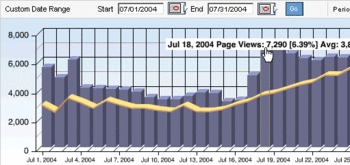
Pages per visitor.
This is the other critical statistical factor to find about. How many pages each
visitor to that site gets to see?
Time on site.
Probably indispensable as the two other indicators above the time on site shows
clearly if the visitors of a certain site spend serious time on it or are just passers-by
realizing that this is not the site for them.
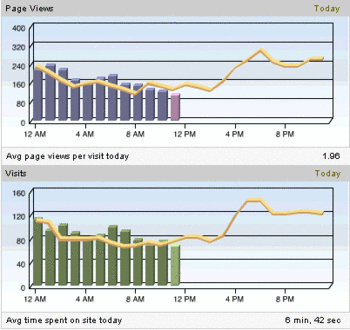
Repeat visitors.
Though very hard to compute with precision this indicator offers valuable feedback
about the stickiness factor of any site by showing how large is the percentage of
Web visitors returning for multiple visits.
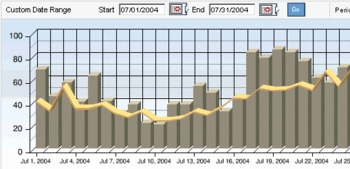
One alternative way to obtain traffic data from sites that do not wish to share
such information is to utilize services like Blogads,
which rely on gathering and sharing page views statistics of their customer sites
to make their advertising agency services more valuable and trusted.
Blogads
http://www.blogads.com/
Blogads is an ad brokering clearinghouse for bloggers and independent
sites.
Through its service it is possible to determine some useful reference data
about the traffic of any of the Web site that runs blogads. Since blogads is quite
popular and established among many blog sites it is possible to get good traffic
references for a large number of sites.
Since web site publishers need to insert a short code inside their web pages to
run the Blogads service, it is next to automatic (just like for Google Adsense)
for Blogads to know how many times any Web page running its code has been viewed.
Intelligently Blogads makes this data accessible to the public, and as a matter
of fact it is one of the driving criteria for how advertisers select their ideal
promotion outlets when using Blogads.
Please see:
http://www.blogads.com/order_html
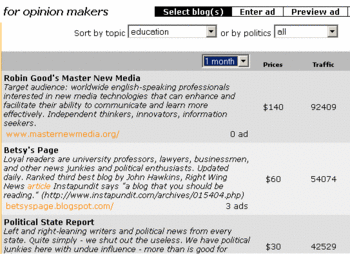
It should be noted that since site owners may not run blogads on all the
pages of their sites, the statistics being shown on Blogads reflect only a minimum
possible number of page views but possibly never the complete absolute number.
Blogads also provides advertising performance indicators to its publishing and
advertising customers (clickthrough ratio on ads), but this data is not publicly
accessible.
Advertising Performance - Clickthrough Ratio
Advertising performance is a very valuable indicator of a Web site credibility
as it provides a tangible reference of how much its readers trust the information,
products and services being offered through it.
Unfortunately this type of information is generally kept under tabs by both advertising
agencies and publishers. It would be very valuable for Web site owners to publish
publicly this information in ways that cannot be counterfeited.
A certified data dump from Google, or other provider would be a welcome addition
to a site credibility public set of indicators.
Where possible request the sharing of this advertising performance information
for any site for which you wish to evaluate overall effectiveness and "traction�.
Google AdSense, which is a service
provided by Google, allowing independent sites to run text-only contextual ads next
to their articles. Google AdSense
provides detailed performance statistics to Web site owners running it.

Similar programs offer equivalent information to both advertisers and publishers,
though this information remains generally highly guarded.
If you, as I recommend, intend to publish or share such advertising performance
information on your Web site, I strongly advise to first inform and obtain a written
permission from your advertising partners.
Other Popularity and Authority Indicators
Newsletter - Mailing List Size
Another major indicator of a site popularity is the size (and quality) of
its mailing list. For mailing list size is generally intended the number of subscribers
to a newsletter or other email-based periodical publication that the web site publishes.
Hundreds, thousands or tens of thousands. What is the number of people who has
chosen to subscribe to your email-based news reports?
The larger the size and the more frequent the publication, the higher
the level of popularity, authority and credibility achieved by that site.
Unfortunately this data is not generally shared or published.
It is my recommendation that Web publishers state their effective circulation
without censorship and by always providing the source reference of that data, if
not a visual proof or better yet a certified audited report.
There are multiple free services and tools that used together may provide
additional sets of data to compute the degree of credibility, authority and popularity
of one or more Web sites.
These include:
Alexa ranking
http://www.alexa.com/
Though Alexa results can not be trusted as absolute measurements of a site popularity,
credibility or rank, they can be very useful in checking overall trends and indicative
evaluations of a site performance over time. It is well know that Alexa results
can be easily faked and influenced with cheap techniques. The statistical results
appearing in Alexa are derived from the surfing patterns of all those users who
have installed the Alexa toolbar. Nonetheless such Alexa toolbar users maybe over
ten millions, they remain a very limited audience sample, strongly slanted to represent
the US-based Web geek demographic that best represent Alexa users: online marketing
specialists, web site owners, webmasters fanatically interested in the ranking and
visibility of their sites.
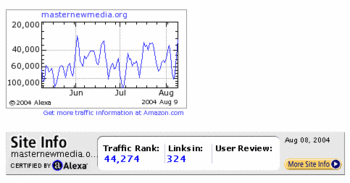
"In addition to the biases above, the Alexa user base is only a sample of the
Internet population, and sites with relatively low traffic will not be accurately
ranked by Alexa due to the statistical limitations of the sample. Alexa's data come
from a large sample of several million Alexa Toolbar users; however, this is not
large enough to accurately determine the rankings of sites with fewer than roughly
1,000 total monthly visitors. Generally, Traffic Rankings of 100,000+ should be
regarded as not reliable because the amount of data we receive is not statistically
significant. Conversely, the more traffic a site receives (the closer it gets to
the number 1 position), the more reliable its Traffic Ranking becomes."
Source:About the Alexa Traffic Rankings
http://pages.alexa.com/prod_serv/traffic_learn_more.html
Alexa traffic ranking is really only relatively good for the top 50,000 websites.
It is also a good pattern indicator for any site general trends.
Where Alexa can be useful on a busy site is for hunting related sites and seeing
patterns.
How important is Alexa?
http://www.webproworld.com/viewtopic.php?t=4562
Alexa.com, how valuable is this?
http://www.webmasterworld.com/forum16/907.htm
Alexa Accuracy?
Alexa Review Issue
"not
100& accurate"
"Alexa is
trying to expand the use of its toolbar (and thus the accuracy of its statistics)."
"Alexa
isn't real high on my list of respectable search sites. The accuracy is way off,
and misleading to many."
"Of course Alexa isn`t a tool to get the world ranking on most visited sites accurat,
completly agree with that, however I think it has some accuracy if you compare sites
that are in similar or the same business."
"Alexa Web Search
is a funny topic. Amusing, in fact. Alexa, despite the fact that it has a very
small user base, takes it upon itself to issue"traffic rankings". These lopsided
and absurdly inaccurate traffic rankings in themselves are enough to warrant a chuckle;
but this topic gets
much funnier when you see CEO's of affiliate marketing corporations and SEO amatuers
brag about their Alexa traffic rankings."
"Alexa measures
Web site use based on the traffic patterns of those who have installed and use the
Alexa toolbar. Since probably 80-90% of Web surfers have probably never heard
of Alexa, it's not something you can use as a marketing tool."
Find out more by yourself starting from here:
http://www.google.com/search?q=alexa+accuracy&hl=it&lr=&ie=UTF-8&oe=UTF-8&c2coff=1&start=10&sa=N
Yahoo Web Rank
http://help.yahoo.com/help/us/companion/webrank
In a move that may further thrill the professionals working in SEO and SEM areas,
Yahoo has quitely rolled out something very similar to the famous
Google PageRank. This is a system that allows Yahoo to calculate the rank of
any Web site by leveraging the browsing habits when using the new Yahoo!'s Web Rank
Toolbar. The ranking mechanism places any individual Web site on a popularity scale
going from 1 to 10 based on the number of links pointing to that site and other
factors Yahoo takes into account. For those who wish not to install the new
Yahoo Web Rank Toolbar,
or that do not have MSIE installed as their default browser, Yahoo Web Rank data
can also be accessed by by going to
http://www.digitalpoint.com/tools/webrank/
(March 29th 2004 - Source:
Yahoo's Own PageRank: Web Rank - RG News)
Given the very recent introduction of this tool, its relatively limited
adoption and the results I have seen during my ongoing tests, I would not consider
this a critical authority indicator, made exception for the top 100,000 sites, for
which, given enough time, the statistical data will provide some useful reference
information. Promising.
Link Appeal
http://www.webmaster-toolkit.com/link-appeal.shtml
Link Appeal calculates the desirability rating of having a link on the url you specify.
This calculation includes four factors:
a) Google PageRank
b) number of outbound links
c) the overall percentage of links to html
d) Alexa traffic ranking
Link appeal calculates an overall score (1-10) based on the above factors.
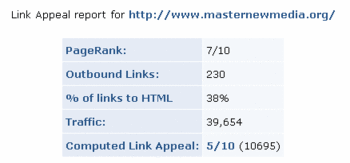
Ranking
http://www.ranking.com
Ranking offers a similar service to Alexa attempting
to provide absolute ranking, page views, visitors, links and authority value to
each and every site measured. Unfortunately results are far from being anything
I would rely on. Ranking.com utilizes an approach similar to Alexa's by
polling the browsing behaviour of all users of the
Browser Accelerator software/toolbar
sold by a sister company (both are woned by EMERgency24
Inc.). The overall polling sample is a group made of under a million users,
hardly providing any effective statistical relevance to the data reported on a global
Internet scale.
Unreliable. Use only as a testing reference or to measure Top 10,000 performers.
Popularity, Authority And Credibility In The Blogosphere
Also inside the blogosphere there are multiple services which greatly
facilitate the measurement of authority of and popularity of any blog site. By utilizing
link popularity, the number of citations on other sites and the number of
trackbacks from other blogs. Far from being very precise in absolute terms,
some of these indicators offer a good, relative measure, of a blog popularity, authority
and consequent credibility in its field.
These include:
Technorati
http://www.Technorati.com/
Technorati provides the most respected and comprehensive authority index
about the blogosphere. Technorati allows easy assessment of any weblog popularity/authority
by providing a uniquely valuable statistical census of the blogosphere in near-real-time.
By querying the Technorati search interface with the URL of a weblog one is provided
with the following information:
a) the number of blogs linking a specified blog
b) the total number of links arriving to that blog from the previous blogs
(When it works), Technorati provides an outstanding authority indicator for any
active Weblog on the Internet.
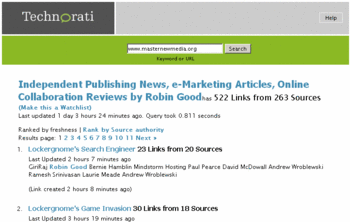
PubSub Linkranks
http://www.pubsub.com/linkranks.php
Link ranks are a way of measuring the strength, persistence, and vitality of links
appearing in weblogs. From this data is possible to extract valuable information
supporting the ranking of blog sites according to their link popularity and value.
Link ranks takes into consideration scores for each linking site; domains are then
scored also with reference to the values of the sites that link to them. The theory
is basically that these are the links you're most likely to click on, if you read
a weblog at random. Unlike Google's PageRank system, link ranks are not iterative.
Rather, PubSub bases Link ranks on a simple formula that only looks at local links
- links which are within one or two steps of any target site. Also important to
note is that Link ranks only looks at links which are in weblog entries - and not
those that may appear on the side bars or inside so-called blogrolls. To calculate
link ranks, PubSub generates a link score for each domain. Link scores are calculated
in three steps: first, a point value is found for every site that links to other
sites. Second, the point values are used to generate link scores for each domain.
Finally, the daily scores are weighted over a fixed period to arrive at an aggregate
score for the site - this ensures that more recent links are given more value than
older links.
Interesting. Promising.
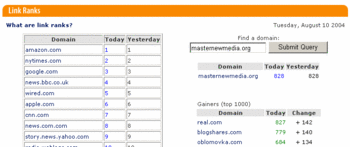
Daypop Blogstats
http://www.daypop.com/blogstats
The DayPop Blogstats facility shows a blog's ranking in terms of Daypop's citation
scoring. It also shows similar weblogs based on link patterns (only the Top 1000
blogs ranked by Citations and Daypop Sponsors' Blogs have data for Similar Blogs).
A new service, with some interesting features, but too little documentation.
To be followed. (Unfortunately scoring criteria are not explained on the site.)
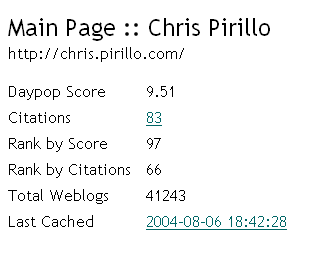
Backlinks with TouchGraph GoogleBrowser
http://www.touchgraph.com/TGGoogleBrowser_Backlinks.html
Few people know that the TouchGraph GoogleBrowser offers a fascinating visual view
of the backlinks to any Web site. Fascinating for serendipitous exploration, visual
comparisons and experimental research. Mostly unusable for effective statistical
reference and authority assessment.
Tactical usefulness. Exploratory and research use.
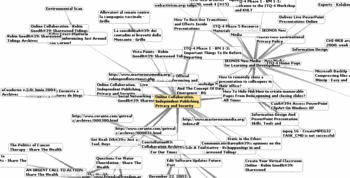
There are other similar services from Feedster (Links),
Blogstreet (Visual
Neighborhood) and others, but none seems to be working reliably as of this writing.
Credibility Factors
The Stanford Web Credibility Research Project
http://credibility.stanford.edu/
The Stanford Web Credibility Research Project goal is to understand what leads people
to believe what they find on the Web. As part of this ongoing project the Stanford
Web Credibility Research Project:
- performs quantitative research on Web credibility.
- collects all public information on Web credibility.
- acts as a clearinghouse for this information.
- facilitates research and discussion about Web credibility.
- helps designers create credible Web sites.
Credibility Guidelines
http://credibility.stanford.edu/guidelines/index.html
Evidence-based articles on Web credibility
http://credibility.stanford.edu/credlit.html
To subscribe to their newsletter please send a request to:
mailto:[email protected]
Captology - Stanford Persuasive Technology Lab
http://www.captology.org
The Stanford Persuasive Technology Lab creates insight into how computing products
-- from websites to mobile phone software -- can be designed to change what people
believe and what they do. Like human persuaders, persuasive interactive technologies
can bring about positive changes in many domains, including health, business, safety,
and education. With such ends in mind, the Stanford Persuasive Technology Lab is
creating a body of expertise in the design, theory, and analysis of persuasive technologies,
an area called "captology."
Learn more about captology and its key core concepts:
http://captology.stanford.edu/Key_Concepts/key_concepts.html
To subscribe to their newsletter please go to:
http://captology.stanford.edu/Newsletter/newsletter.html
How Do People Evaluate a Web Site's Credibility?
Results from a Large Study
October 29 2002
Here are some key results emerging from this research.
More
detailed information is accessible here.
Design Look
46.1% Overall
Information Design/Structure
28.5% Overall
Information Focus
25.1% Overall
Company Motive
15.5% Overall
Information Usefulness
14.8% Overall
Information Accuracy
14.3% Overall
Name Recognition and Reputation
14.1% Overall
Advertising
13.8% Overall
Information Bias
11.6% Overall
Writing Tone
9.0% Overall
Identity of Site Operator
8.8% Overall
Site Functionality
8.6% Overall
Customer Service
6.4% Overall
Past Experience with Site
4.6% Overall
Information Clarity
3.7% Overall
Performance on Test by User
3.6% Overall
Readability
3.6% Overall
Affiliations
3.4% Overall
"The data showed that the average consumer paid far more attention to the superficial
aspects of a site, such as visual cues, than to its content. For example, nearly
half of all consumers (or 46.1%) in the study assessed the credibility of sites
based in part on the appeal of the overall visual design of a site, including layout,
typography, font size and color schemes. This reliance on a site's overall visual
appeal to gauge its credibility occurred more often with some categories of sites
then others. Consumer credibility-related comments about visual design issues occurred
with more frequency with finance (54.6%), search engines (52.6%), travel (50.5%),
and e-commerce sites (46.2%), and with less frequency when assessing health (41.8%),
news (39.6%), and nonprofit (39.4%) sites."
http://www.consumerwebwatch.org/news/report3_credibilityresearch/stanfordPTL_abstract.htm
This research was conducted in partnership with
Consumer Webwatch, a part of
Consumers Union (the nonprofit group
that publishes Consumer Reports).
How Do Experts Evaluate the Credibility of Web Sites?
http://tinyurl.com/6cxs2
Related to the research above, thisis a study that compared how experts and nonexperts
evaluated the credibility of Web sites. The focus was on health sites and finance
sites. This research was done by the Stanford Web Credibility Research Project group
in partnership with Sliced Bread Design, LLC, and Consumer Webwatch, a part of Consumers
Union (the nonprofit folks who publish Consumer Reports).
Full Source.
Consumer WebWatch Guidelines To Improve Credibility
http://www.consumerwebwatch.org/bestpractices/index.html
1) Identity:
- Web sites should clearly disclose the physical location where they are produced,
including an address, a telephone number or e-mail address.
- Sites should clearly disclose their ownership, private or public, naming
their parent company.
- Sites should clearly disclose their purpose and mission.
2) Advertising and Sponsorships:
- Sites should clearly distinguish advertising from news and information,
using labels or other visual means. This includes "in-house" advertising or
cross-corporate ad sponsorships.
- Search engines, shopping tools and portals should clearly disclose paid
result-placement advertising, so consumers may distinguish between objective
search results and paid ads.
- Sites should clearly disclose relevant business relationships, including
sponsored links to other sites. For example: A site that directs a reader to
another site to buy a book should clearly disclose any financial relationship
between the two sites.
- Sites should identify sponsors. The site's sponsorship policies should be
clearly noted in accompanying text or on an "About Us" or "Site Center" page.
3) Customer Service:
- Sites engaged in consumer transactions should clearly disclose relevant
financial relationships with other sites, particularly when these relationships
affect the cost to a consumer.
- Sites should clearly disclose all fees charged, including service, transaction
and handling fees, and shipping costs. This information should be disclosed
before the ordering process begins.
- Sites should clearly state and enforce policies for returning unwanted items
or canceling transactions or reservations.
4) Corrections:
- Sites should diligently seek to correct false, misleading or incorrect information.
- Sites should prominently display a page or section of the site where incorrect
information is corrected or clarified.
- Sites should strive to mark content with its published date when failing
to do so could mislead consumers.
- Sites should clearly state their policy on a consumer's rights if a purchase
is made based on incorrect information on the site.
5) Privacy:
- Site privacy policies should be easy to find and clearly, simply stated.
- Sites should clearly disclose how personal data from site visitors and customers
will be used. Personal data includes name, address, phone number and credit
card number.
- Sites should disclose whether they use browser-tracking mechanisms such
as "cookies," and other technologies such as Web beacons, bugs and robots.
- Sites should explain how data collected from them will be used.
- Sites should notify customers of changes to privacy policies, and provide
an easy opt-out alternative.
***
These guidelines are by no means exhaustive, but they are based on the results
of an http://www.consumerwebwatch.org/bestpractices/index.html">extensive
research project conducted by Consumer
WebWatch in December 2001 and January 2002; on expert opinion from our board
of advisers and other information professionals; and other qualitative research.
Other Resources On Web Credibility
An Educators' Guide to Credibility and Web Evaluation
http://lrs.ed.uiuc.edu/wp/credibility/index.html
"You may have heard that 'knowledge is power,' or that information, the raw material
of knowledge, is power. But the truth is that only some information is power: reliable
information" ( Harris, R. ). The Internet is a virtual library, consisting of an
unlimited amount of information. Anyone is allowed to publish and access this information.
Furthermore, the sites are created for a variety of purposes to inform, persuade,
sell, and change an attitude or belief. The sites are not monitored, edited, regulated,
or approved. All of these factors remind us of the fact that information that has
been published on the Web, is no indication of its believability or accuracy. ...
A resource that is credible is one which shows evidence of authenticity, reliability
and believability ( Harris, R. ). Basically, the key to credibility is trust;
How well can one trust the information found on the Internet, as well as other resources?"
it also includes:
Why Evaluate Web Information
Methods of Evaluation
Teaching Web Evaluation
Bibliography
-
Transparency and Credibility On The Web: How To Increase Them
Transparency and credibility are probably among the hardest assets to build
online. The lack of a physical presence greatly diminishes our normal ability
to assess an organization/company credibility by looking at visual clues and
by having direct communications with its staff. On the Web all of us need to
rely on secondary indicators to assess a site true credibility, and the ones
we look for more often are the ones that probably we take least care in maintaining
on our own sites. According to extensive research conducted by the Stanford
Credibility Research Lab, the following list of ten items represents the most
critical items to address when trying to improve a site authority in its field:...
-
Critical Factors in Gaining Online Credibility
"There are about 35 million websites on the Internet - by 2014 there'll be an
estimated 150 million, not including personal websites. With so many people
online and so many websites competing with yours, if you can't persuade Internet
users to be loyal to your website then someone else will. According to BJ Fogg,
the world's leading researcher on web credibility, web credibility is about
making your website in such a way that it comes across as trustworthy and knowledgeable.
His book is so good that even Jakob Nielsen himself dedicated a whole Alertbox
issue to it." So what are the most immediately useful actions one can take to
improve the credibility of anyone site?
-
How To Increase Credibility And Online Visibility Through Free Sharing Of Rich
And Relevant Content
If you've spent any time online trying to promote your Web site or online business,
you must have very likely realised that one of the most effective ways to augment
your credibility, authority, visibility, prestige and reach on a long term basis
is to write your own research articles and freely distribute them to independent
publishers, newsletter editors and major Web sites along with your one paragraph
bio/credit line and a clear link back to your Web site. The reasons why this
free sharing marketing strategy is so effective include the following...
-
Extend Reach, Visibility, And Online Authority By Syndicating Your News: FeedRoll
Offers A Win-Win Proposition
FeedRoll is an online service which allows independent Web publishers to facilitate
the syndication of their news content on other Web sites, while controlling
feed features and tracking access and clickthrough ratios. This is an evolution
of what I and many others have been doing for a while to extend our reach, credibility
and presence across multiple sites. The problem FeedRoll addresses is how independent
Web publishers can make their content available for easy syndication to other
publishers/bloggers. An increasing number of sites now produce RSS/ATOM feeds,
which is great, but to syndicate those news feeds you still then need to install
some server side software on such potential syndicating partner sites to parse
the news feed and to format it for their site look and feel. This would be an
insurmountable hurdle for most non technical publishers.
- Convey Professional
Credibility On Your Site
Is your goal as a business owner primarily focused on helping your clients increase
sales, improve efficiency, prevent a crisis or understand why a particular strategy
might work? If so, you likely want to gain your clients' trust so that you'll
be chosen for their next project. Conveying credibility through a Website is
a challenge we all face, but Web professionals are a unique case. We must convince
potential clients of our credibility, experience and professionalism to such
a degree that they're eager to contact us with regards to projects that may
be worth thousands of dollars. A great many designers, developers and business
owners in today's market conduct their business primarily over the Internet,
so we may never come face to face with clients or business contacts. Working
with people at a distance definitely presents a challenge, but its one that
can easily be overcome. How? Give your site visitors the facts!
Credibility Assessments
of Online Health Information: The Effects of Source Expertise and Knowledge of Content
"Perceived expertise, bias, fairness, truthfulness, accuracy, amount of use,
depth or completeness of message, prior knowledge and message quality have all
emerged as components of credibility.
Recognizing the large number of indicators and dimensions used to
assess the construct of credibility, West (1994) validated two frequently used
scales of credibility, by Gaziano and McGrath (1986) and Meyer (1988). The
five dimensions created in the Meyer (1988) study were found to be: "...valid
and reliable measures of credibility; they consisted of fairness, bias, depth,
accuracy, and trustworthiness." (West, 1994, alpha = .92, p. 163). These
five indicators, as well as 12 others, were listed in the Gaziano and McGrath
(1986) scale. When evaluating which items to include, it must be determined
whether credibility of the source or of the stimuli (content) is being measured,
and whether credibility should be measured from the receiver's perspective or
from the source's attributes. (Rubin, Palmgreen, & Sypher, 1994). That being
said, this study identified items related to the content from the receiver's
perspective.
While these as well as other dimensions have been found to be significant
components in understanding perceived credibility, there are other factors that
have helped to gain understanding of how people perceive credibility, such as
age, education, amount of use, reliance and medium (Greenberg, 1966; Johnson
& Kaye, 1998; Wanta & Hu, 1994). Although earlier studies had indicated that
television was a more credible information source than newspapapers for most
people, a more recent evaluation of media credibility indicated that people
consider information obtained online to be as credible as television, radio,
and magazine information, but not as credible as information in newspapers
(Flanigan & Metzger, 2000)."
Source: Credibility
Assessments of Online Health Information: The Effects of Source Expertise and Knowledge
of Content
Matthew S. Eastin
School of Journalism and Communication
The Ohio State University
Ethics and Credibility In Online Journalism (PDF)
Leo: Assessing
The Credibility Of Online Resources
Evaluating Credibility Of information
On The Internet (PDF)
How Do You Measure Web Site Success?
How do you measure the success of your Web site? As more and more people ask me
this question, I have learned that the answer is never the same. Though there are
some effective public indicators of your site success, it is evident that unless
the goals have been defined in detail, success will remain an epheremous goal to
reach. Here are my
seven recommended steps you need to take to be able to measure the success of
your Web site in a reliable and sound way.
Suggest Other Resources
I am sure I am missing on some other valuable resources out there that may be
able to well complement this initial resource list.
If you are aware of them, please do not hesitate in submitting them to
me via either the comments area here below or by sending me an email at Robin.Good[at]masternewmedia.org
Thank you.
| 













